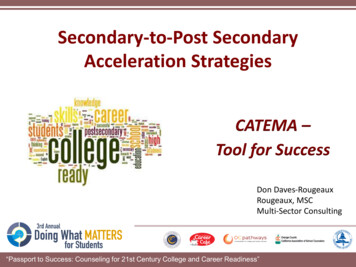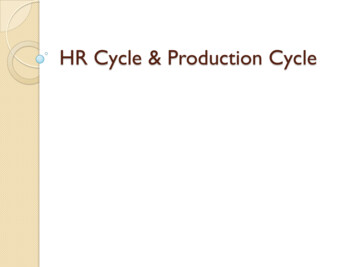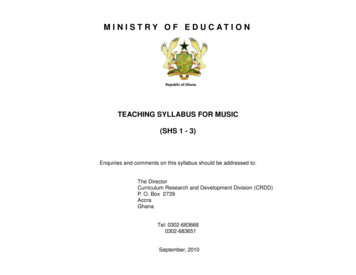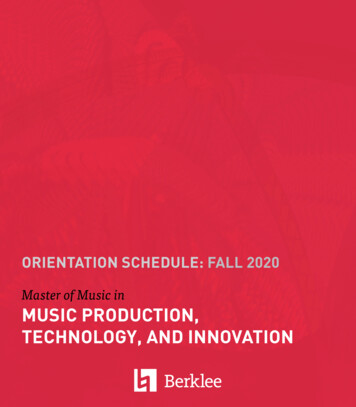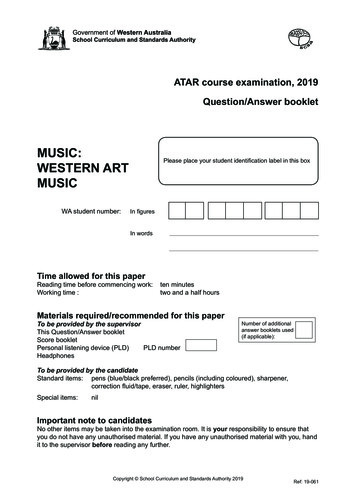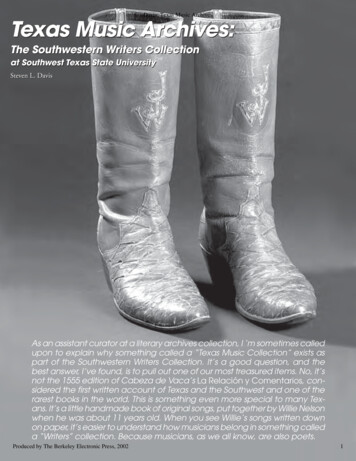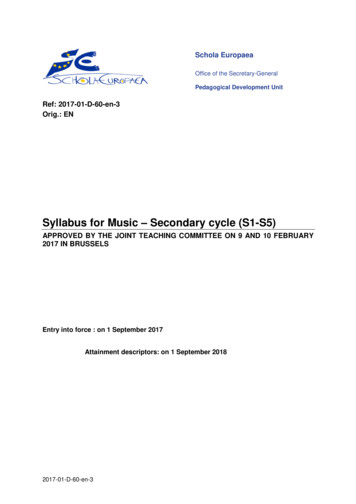
Transcription
Schola EuropaeaOffice of the Secretary-GeneralPedagogical Development UnitRef: 2017-01-D-60-en-3Orig.: ENSyllabus for Music – Secondary cycle (S1-S5)APPROVED BY THE JOINT TEACHING COMMITTEE ON 9 AND 10 FEBRUARY2017 IN BRUSSELSEntry into force : on 1 September 2017Attainment descriptors: on 1 September 20182017-01-D-60-en-3
Index1:2:3:Preface3General Objectives41.1:General Objectives of the European Schools41:2:Objectives of the subject Music4Didactic Principles2.1:General Didactic Principles62.2:Didactic Principles for Music Education6Learning Objectives3.1:Overall Learning Objectives3.2:Learning Objectives for the different cycles3.2.1: Years S1-S33.2.2: Years S4-S54:5:6Content for the subject music889910124.1 Content in music education for S 1-34.1.1 Knowledge and Skills Framework for S 1-3:12134.2 Content in music education for S 4-54.2.1 Five topics and a final project4.2.2 The three main areas of musical competence in S 4-54.2.3 Knowledge and Skills Framework for S 4-5:14141617Assessment in music18General Principles of Music Assessment185.1:Assessment Practice185.2:Music Attainment Descriptors195.3:Attainment descriptors for the end of S3205.4:Attainment descriptors for the end of S5242017-01-D-60-en-32/28
PrefaceMusic is a unique form of communication that influences the way students feel, think, act andunderstand their world. Music is an important part of each young person's identity both as anindividual and as a European citizen. Music classes typically comprise students from manydifferent European countries. Music education enables students of the European Schools tobuild bridges between their various cultural backgrounds.In lessons with expert music teachers, young people acquire competencies that help themshape the musical world around them. Through activity-based learning, music-making andworking with conventional instruments and contemporary media, music lessons contributesubstantially to students’ education, artistry, and their acquisition of appropriatecommunication skills, far beyond the boundaries of the subject and school itself.Music education fosters in student the qualities and skills necessary to develop a diverse setof interests and participate in artistic citizenship. The insights provided by music educationenable students to become aware of the significance of musical, artistic, cultural, literary, andmedia diversity. Students come to recognise the importance of cultural traditions andcontemporary aesthetic concepts in societal development. Furthermore, they are inspired toengage with contemporary and historic music, arts and culture.The syllabus for Secondary Music builds on the learning objectives of the Primary MusicCurriculum.2017-01-D-60-en-33/28
1:General Objectives1.1:General Objectives of the European SchoolsThe European Schools have the two objectives of providing formal education and ofencouraging students’ personal development in a wider social and cultural context. Formaleducation involves the acquisition of competences (knowledge, skills and attitudes) across arange of domains. Personal development takes place in a variety of spiritual, moral, socialand cultural contexts. It involves an awareness of appropriate behaviour, an understanding ofthe environment in which students live, and a development of their individual identity.These two objectives are nurtured in the context of an enhanced awareness of the richnessof European culture. Awareness and experience of a shared European life should leadstudents towards a greater respect for the traditions of each individual country and region inEurope, while developing and preserving their own national identities.The students of the European Schools are future citizens of Europe and the world. As such,they need a range of competences if they are to meet the challenges of a rapidly-changingworld. In 2006 the European Council and European Parliament adopted a EuropeanFramework for Key Competences for Lifelong Learning. It identifies eight key competenceswhich all individuals need for personal fulfilment and development, for active citizenship, forsocial inclusion and for employment:1.2.3.4.5.6.7.8.Communication in the mother tongueCommunication in foreign languagesMathematical competence and basic competences in science and technologyDigital competenceLearning to learnSocial and civic competencesSense of initiative and entrepreneurshipCultural awareness and expressionThe European Schools’ syllabuses seek to develop all of these key competences in thestudents.1:2:Objectives of the subject MusicThe Music Syllabus for Years 1-7 aims to support teachers in meeting the challenge ofproviding for the musical needs and aspirations of all young people in the European Schools.It is underpinned by a belief that every young person is entitled to a broad musical educationthat meets their musical needs, interests and aspirations. The syllabus builds upon thelearning that takes place in primary schools but also recognises that young people bring tothe music classroom musical skills, experiences, interests and aspirations developed in theirlives outside of school.Music is an important means by which young people shape their sense of individual andcollective identity. They use it as a means for expressing ideas, concepts, feelings andthoughts and to come to a richer and more meaningful understanding of the world. Musicalso develops creative and lateral thinking skills which have a positive impact on other areasof learning. Most importantly, music is a practical subject where young people gain mostwhen they are enabled to act as artists and musicians.2017-01-D-60-en-34/28
Positive interaction with music develops students' competence as learners and increasestheir self-esteem. It brings together intellect and feeling and enables personal expression,reflection and emotional development. Music can help foster personal development andmaturity, engender a sense of achievement and self-worth, and develop the ability to workwith others. Music education develops students' critical skills: their ability to listen, to value awide variety of music, and to make judgements about musical quality. It also develops selfdiscipline, creativity, aesthetic sensitivity and fulfilment.The music curriculum supports young people's musical development through providing themwith a range of challenging and enriching musical encounters which lead to increasinglysophisticated and meaningful relationship with music as composers 1 , performers andlisteners. Music plays a key role in delivering one of the key objectives of the EuropeanSchools which is to provide young people with opportunities for creative endeavour and topromote an understanding of a common European heritage.The music syllabus fosters young people’s:CriticalunderstandingCritical engagement with music, developing views and justifyingopinionsCreativityAbility to use existing musical knowledge, skills and understandingfor new purposes and in new contexts. Exploring innovative ways inwhich music can be combined with other art forms.CommunicationExplorations into how thoughts, feelings, ideas and emotions can beexpressed through music.CulturalunderstandingUnderstanding of musical traditions and the part music plays innational, European and global culture and the construction ofpersonal and collective identity.Understanding of how ideas, experiences and emotions areconveyed in a range of music from different times and cultures.1In this document composing is taken to also include improvising.2017-01-D-60-en-35/28
2:Didactic PrinciplesThe music curriculum reflects the common didactic principles of the European schoolsthrough adopting an integrated approach to musical learning and a belief that studentsdevelop through active learning as makers of music.2.1:General Didactic PrinciplesThe learning and teaching of music is based on the following didactic principles:-Integrated teaching and learning: Links and correlations among the different areasof the European School curriculum make learning a more comprehensive andmeaningful experience.-Active Learning: Students gradually become responsible for their own learningprocess.These principles are applied through a variety of teaching and learning approaches andstrategies, the use of differentiated teaching methods and the use of a wide range of learningresources including digital tools and resources.Didactic principles are provided as a guide for the Learning and Teaching.2.2:Didactic Principles for Music EducationThe syllabus is built upon five key principles.There is that, Music education and the assessment of musical learning will:1. Foster the musical learning and development of all young people in the Europeanschools.2. Involve young people in musical activities and experiences which develops theirmusical skills and knowledge.3. Integrate composing, performing and listening and responding.4. Recognise and value the diverse ways in which young people demonstrate musicalunderstanding and development.5. Reflect and value the diversity of music in society and particularly contemporaryEuropean society.Music teaching built upon these key principles demonstrates the following characteristics:PrinciplesThe music syllabus will: Support the musical learning andprogression of all young people inthe European schools. Involve young people in musicalactivities and experiences whichsupport them in developing theirmusical skills and knowledge.2017-01-D-60-en-3Characteristics of Teaching and LearningYoung people learn music in many ways and havedifferent musical interests, strengths and needs.The curriculum and its teaching supports themusical development of all young people, helpsthem to fulfil their musical aspirations andintroduces them to new forms of musicalexperience and music makingInvolves young people in authentic and real-lifemusic-making processes.6/28
Integrate composing, performingand listening activities Recognise and value the manyways in which young peopledemonstrate musical understandingand development Reflect and value the rich diversityof music and musical practices insociety and particularlycontemporary European societyComposing, listening and performing are usuallybrought together within lessons to create richmusical experiences.Teaching and assessment provide opportunities forstudents to demonstrate musical learning andunderstanding in a range of different ways.Teachers adapt their teaching to reflect the musicalexperiences and needs of the young people whosemusical learning they support.Teaching reflects and builds on the diversity ofmusic in society and the many ways in whichpeople engage with music and gain fulfilment fromit.ResourcesAdequate resourcing is a precondition for meeting the musical learning needs of all youngpeople in European Schools. Rich and meaningful musical experience and high musicalachievement is dependent upon access to high quality resources including musictechnology/ICT, instruments and audio equipment. Young people cannot produce highquality musical work from low-quality resources. The following list is a basic minimum:1. Teaching space which allows for a range of individual, group and whole class musicalactivities to take place2. Arrange of good quality acoustic and electronic instruments, including percussion,electronic keyboards, pop and rock instruments and instruments from non-westerncultures as well as amplifiers and microphones3. Good quality audio-visual and digital recording equipment, including MP3, CD andDVD4. Access to the world-wide web within the music teaching rooms5. Arrange of computer-based music technology and software6. A range of digital and print resources7. Opportunities for teachers to share ideas and resources via e-communication and theLearning Gateway.The most important resource however is an expert music teacher who can foster a culture ofmusic making in the school.2017-01-D-60-en-37/28
3:Learning Objectives3.1:Overall Learning ObjectivesThroughout the years S1-S7, teaching and learning in music will address the subject content,learning objectives and didactic principles of the music syllabus fostering the development ofyoung people's musical skills, knowledge and understanding in the three main musicalcompetencies of composing and improvising, performing, and listening & responding.Musical Learning Composing and Improvising-Developing and shaping musicalelements into expressive ideasand structures for a range ofmediums and purposes, includingthe use of music technology (ICT).Demonstrating an increasingawareness of musical style, genreand tradition.-Activities and Processes Work collaboratively on compositions andimprovisations recognising, valuing andresponding to the contributions made byothers to the musical processes andoutcomes.Create, develop and extend musical ideaswithin musical structures.Create, develop and extend musical ideaswithin the conventions of a range of musicalstyles, traditions and genres.Make expressive use of musical elements,devices, tonalities and structures usingconventional instruments, voices and ICT.Employ a range of means to record theirmusic making including using notations anddigital technologies.Performing- Perform and improvise fluently andexpressively both in groups andindividually with an increasingawareness of style, genre andtradition. 2017-01-D-60-en-3Sing and perform on instruments in solo orgroup contexts with musical expression andsecure technical control and an awarenessof ensemble.Perform with an awareness of musical style,context and occasion.Work collaboratively on musicalperformances and compositions,recognising, valuing and responding to thecontributions made by others to the musicalprocesses and outcomes.Develop an understanding of differentmusical practices through performing musicfrom a range of traditions and cultures.Perform by ear and from a range ofnotations.8/28
Listening and respondingListening and responding in thecontext of composing, performing andimprovising.- Listening and responding to musicfrom a wide range of styles, traditionsand cultures.-3.2: Respond to music through composing,improvising and performing.Listen with discrimination to music from awide range of traditions and cultures.Respond to music through talk, discussionand writing using appropriate technical andnon-technical language.Learning Objectives for the different cyclesThis section sets out the main learning objectives to be attained at the end of S3, S5 and S7.3.2.1: Years S1-S3The syllabus for Years 1-3 builds upon the skills, knowledge and understanding developed inthe Primary Years and reflects the principles and the rationale set out earlier in this syllabus;particularly that young people's musical learning should take place through musicalencounters involving performing, composing, and listening and responding. The aim of thesyllabus in Years 1-3 is to provide students with a secure foundation of musical knowledge,skills and understanding through a broad-based approach which addresses the main areasof musical competenceComposing and improvising:Learning ObjectiveBy the end of S3 students can: compose and improvise music in simple structures to agiven or chosen stimuli; make expressive and appropriate use of melody, rhythm,harmony, and dynamics demonstrating an awareness of the characteristics of a limitedrange of voices and instruments.Performing:Learning ObjectiveBy the end of S3 students can perform music appropriate to their age and musicaldevelopment with fluency, expression, technical control and making expressive use ofdynamics, articulation and phrasing.Listening & Responding:Learning ObjectiveBy the end of S3 students can- listen and respond to music in the context of improvising and performing.- recognize some common musical styles and their characteristics.- draw on appropriate technical and non-technical vocabulary to describe anddiscuss music.2017-01-D-60-en-39/28
3.2.2: Years S4-S5The syllabus for Years 4-5 is topic-based and builds upon the skills, knowledge andunderstanding that students have developed in Years 1-3. It reflects the principles and therationale that young people's musical learning should take place through musical encountersinvolving composing, performing and listening to music. Topics reflect the breadth andvariety of music genres and traditions across the world with a particularly focus on Europeanmusic in all its diversity.The aim of the curriculum in Years 4-5 is to provide students with progressive developmentof their musical knowledge, skills and understanding in the context of in-depth studies of arange of musical genres, styles and traditions. To gain a meaningful understanding of musicyoung people develop critical awareness of its context, its history and its potential for futuredevelopment.The above-mentioned broad-based approach addresses:Composing and improvising:By the end of S5 students can compose / improvise extended music for a particularcontext, occasion and in response to a brief or musical or non-musical stimuli.Product Extended compositions / improvisations are characterized by creative andappropriate choice and use of :- instruments, voices and digital technologies demonstrating andawareness of their technical capabilities and characteristics- musical elements, structures and devicesProcess- The appropriate and creative use of the musical characteristics,devices and processes from a range of musical styles and traditions.The process of composing and preparing improvisations is characterized by:- A clear musical intention- An ability to critically reflect and revise in time or over time in order torefine their work and meet the musical intention- The identification and use of appropriate and inspiring stimuli- Adopting appropriate working practices that support creativity andenables deadlines to be met.Performing:By the end of S5 students can perform music on their own and with others with fluency,expression, and a sense of style.Product Performances are characterized by: A sensitive and stylistically appropriate use of articulation, dynamicsand phrasing. An awareness of the musical characteristics and performingconventions of a range of musical styles and traditions. Good sound quality which is appropriate to the musical style. The ability to draw on a broad range of instrumental and vocaltechniques. A good awareness in ensemble playing.Process The foundation for successful performances are Appropriate choice of appropriate repertoire.2017-01-D-60-en-310/28
An understanding of the challenges and aims required to makeprogress. Working strategies for success. Ongoing critical reflection resulting in improved performance.Listening and Responding:By the end of S5 students can: Listen and respond to music in the context of improvising and performing. Recognize the characteristics of a variety of musical styles and sub-divisions of thosestyles Draw on appropriate technical and non-technical vocabulary to describe, discuss andanalyze music. Demonstrate an open minded and inquisitive approach to new musical styles2017-01-D-60-en-311/28
4:Content for the subject musicThis section sets out the relevant contents necessary to meet the learning objectives outlinedabove. Contents are sequenced per cycle: S 1-3 and S 4-5.The content, knowledge and skills to be taught derive from the objectives for the threecurricular units: S 1-3, S 4-5 and S 6-7 and refers to the three main areas of musicalcompetence:A. Composing and ImprovisingB. PerformingC. Listening & Responding4.1Content in music education for S 1-3In years S 1-3 students acquire a solid foundation in the three main areas of musicalcompetence. Music teaching and learning should cover all areas mentioned above.Composing and improvisingComposing and Improvising in S 1-3 is about creating/arranging/producing music throughdeveloping and shaping musical elements into expressive ideas and simple structures.Composing may be in response to: A musical framework for example, an ostinato, chord sequence, blues sequence,creating a melody from a chord sequence; Extra musical stimuli (the use of words or other non-musical ideas as essential part ofthe music): a mood or atmosphere for example scary music; a picture, a poem; a real-world context in which students would want to situate their musicalexpressions. A special occasion or a specific intention of the student.PerformingPerforming music in S 1-3 involves singing and playing music fluently, expressively and withsecure technical control. Students develop knowledge, skills and dispositions, which enablethem to sing and perform by ear and from a range of notations, and to improvise fluently andexpressively both in groups and individually. Their work in groups develops theircollaborative dispositions and their ability to listen to others recognising and valuing thecontributions made by them to the musical processes and outcomes. They also learn how topresent their performances according to the context in which they are taking place.Students in S 1-3 will perform their work by singing, playing on a range of musicalinstruments as well as using electronic devices e.g. computers, tablets, phone apps and anyother emerging media. Students will perform with growing awareness of musical style andcontext, developing an understanding of different musical practices from a range of musicaltraditions and cultures.2017-01-D-60-en-312/28
Listening and respondingListening and responding in S 1-3 is central to all aspects of music making and experience.When performing young people develop and improve their musical performances andunderstanding by listening to themselves and others. They revise and improve their ownperformance through self-evaluation and group-assessment and help others to improvethrough giving constructive feedback.In S. 1-3, students develop their musical vocabularies and their understanding of thetechnical and non-technical language and stylistic characteristics underpinning somecommon musical styles. They use their knowledge to identify how the elements of music(pitch, rhythm, harmony, dynamics and articulation, timbre, texture, forms, and style) areused expressively and structurally in music.Listening and responding also involves the development of those aural and notational skillsneeded to identify, read and write expressive elements of music, for example motifs,melodies, rhythms, and chords. Listening and responding perceptively, students will draw ontechnical and non-technical terminology to discriminate between and to describe musicalelements, devices, instruments and voices from some common musical styles.4.1.1 Knowledge and Skills Framework for S 1-3:To support their composing/improvising, performing, and listening and responding studentsneed to develop competency in the use of conventional, technological and digital resources,music notation skills, and appropriate language and terminology for analysis and criticalreflection upon music.Students will develop a working knowledge and understanding of:1. The characteristics and properties of music materials and elements including:Pitch: high/lowTime: durationTempo:Timbre: tone colourDynamics:Harmony:Texture:Structure:melodic shape (melody pitch time); expressive possibilities indifferent melodic shapes (articulation).Rhythm, beat/pulse; metre, duple metre, triple metre, compoundmetre; subdivisions.Tempo names and tempo gradationsInstrumentation: voices, instruments, electronic sounds and effectsGradations of volume; dynamical accents; dynamic expression.Tonal system: major/minor; chords.Musical sonorities; main melody, accompaniment, harmony.Motif, phrase, repetition/contrast, variation, simple forms e.g. round,verse/chorus, call and response, rondo (ABA).2. Some common musical styles, including examples from: Popular music, particularly current popular musical forms, styles and performers.Jazz and Rock music.Traditional music.Non-western music.Music from the western classical tradition.2017-01-D-60-en-313/28
4.2Content in music education for S 4-5In years 4 and 5, students extend their acquired competence in Years S 1-3 in a topicbased curriculum based on the three areas of musical competence mentioned above.They develop and apply progressively their knowledge, skills, and dispositions in agreater range of musical contexts, traditions and styles.4.2.1 Five topics and a final projectOver the course of the two years, students will study five topics from the list below(approximately one per term). In addition, there is a final project (approximately 25 hours ofstudy time) which takes place in the final period of Year 5.The content, form and organisation of the topics should be negotiated with each student andpersonalised to meet and reflect their needs, interests, and aspirations.-Music for filmContemporary musical styles and culturesMusic for danceMusic for special occasionsMusical theatreEuropean ‘folk’ traditionsMusic and voiceProgramme music in the 19th CenturyComposing during the last 100 yearsMusic for film:In this topic, students will explore how composers achieve appropriately dramatic effectsthrough their deployment of musical materials and resources within a specific narrativecontext. They will study some music examples from different films and genres, and composemusic for a short film extract. This topic provides an outstanding opportunity to developstudents composing skills using music technology.Contemporary popular music styles and cultures:In this topic, students will engage with contemporary music styles and cultures over the lastdecade. Knowledge of the antecedents of styles, which have developed over the period, willsupport a growing understanding of contemporary popular music and the various fusions thatare typical in popular song culture. The topic involves students in performing songs/music ofthe period and composing their own music in contemporary styles informed by theirknowledge of the distinctive characteristics of music from different world traditions, and of theimpact of music technology on the creation and performance of popular song styles.Music for dance:In this topic, students will investigate, create and perform various forms and styles of sociallyembedded dance music, exploring how music is produced for various types of dance, andhow the context influences its creation, performance and audience.Music for special occasions:In this topic, students will explore the ways in which composers and other musicians haveresponded to briefs and commissions to produce music suitable for a variety of events. Theoutcome of this topic might be a composition for a special occasion or to meet therequirements of a brief set by the music teacher.Musical theatre:In this topic, students will explore the ways in which musical theatre has developed itsvarious forms and styles, and how composers, choreographers, designers, directors and2017-01-D-60-en-314/28
performers co-operate to respond to the challenges of this multi-disciplinary genre. Studentswill listen to and perform theatre music from a wide range of musical theatre as well ascompose their own examples of musical theatre songs.European folk traditions:In this topic, students will study some examples of traditional music in Central and EasternEurope, and investigate the use of folk elements in European music of the 19th and 20thCentury, also to explore the meaning of folk music for national culture(s) and understanding.Students might be encouraged to integrate aspects and characteristics of traditional musicinto their own compositions as well as perform examples of traditional music.Music and voice:In this topic, students will investigate and perform various forms and styles of singing (soloand choral) in Romantic and popular music from 1850 up to the present day. They willexplore different types of song, and the contextual influences affecting its creation,performance and audience.Programme music in the 19th Century:In this topic, students will engage with 19th Century music of a narrative or descriptive kind.They explore the attempts to depict objects and events in music, and investigate therelationship of music to external texts or sources.Composing in the last 100 years:In this topic, students will explore some of the major composing styles from the last 100years as the source for their own composing. They will analyze the characteristics of thesestyles and some representative works from them, and use the understanding that isdeveloped from this study to produce their own compositions and improvisations.Final Project: portfolio presentation of personal musicianship:This project should be chosen by the student, personalised, and focus particularly on his/herindividual musical interests, aspirations and strengths. It should bring together the musicalknowledge, skills and understanding developed during Years 4 and 5.Where appropriate, the final project may serve as means of enabling effective transition fromYear 5 to Years 6-7. The project may take form of preparing an individual or groupperformance, composition, multi-media presentation or a combination of these.2017-01-D-60-en-315/28
4.2.2 The three main areas of musical competence in S 4-5Composing and improvisingIn this cycle students build on their learning in S1-3 demonstrating in their composing andimprovising a growing technical fluency, skill and creativity and an increasing awareness ofstyle and tradition. They use different forms of music notations and digital technologies, todocument and store their musical work ideas of their music, for example rhythmic andmelodic phrases and harmonic sequences.PerformingIn this cycle students build on their learning in S 1-3, demonstrating a growing technicaldevelopment and awareness of the technical capabilities of their instruments/voices andincreasing awareness of style, tradition and genre. They perform by ear and using
Music teaching built upon these key principles demonstrates the following characteristics: Principles The music syllabus will: Characteristics of Teaching and Learning Support the musical learning and progression of all young differentpeople in the European sch
